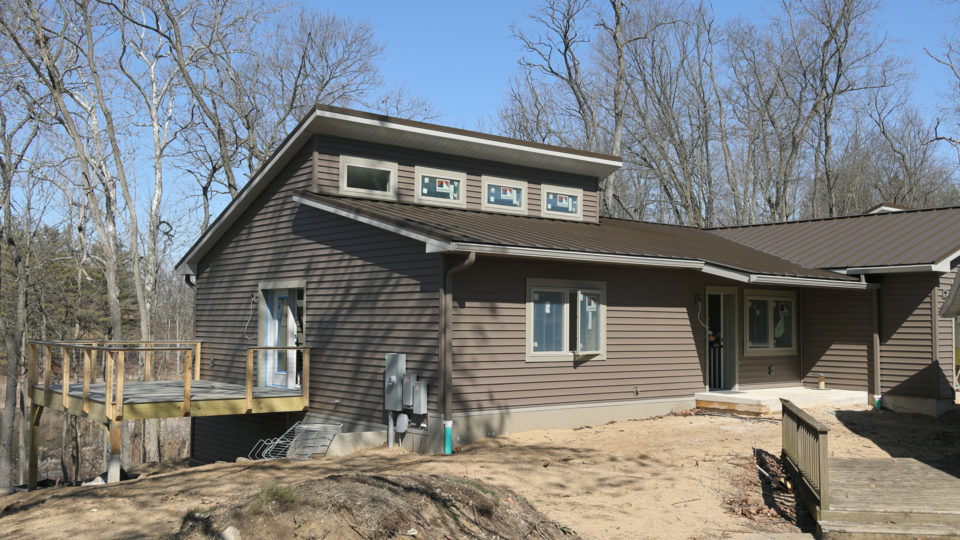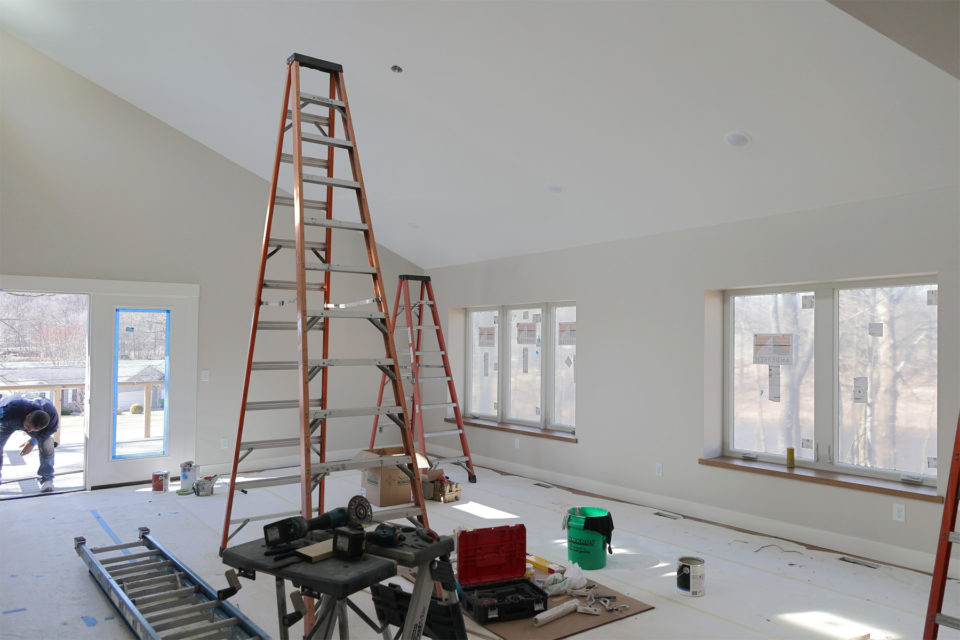
Two staff families will soon be inhabiting our new staff housing duplex, Fenwood. Camp Friedenswald entered this building project with a commitment to sustainable and green building practices and we are delighted with the results! We received excellent input on green building strategies from Alan Ediger, architect, and Dana Miller, a builder experienced in green-design. In searching for a licensed builder in Michigan with a focus on green building, we found Abueva Builders out of Kalamazoo, Michigan. Abueva’s philosophy focuses on three main tenets: environmentally conscious, exceptional energy efficiency, and universal design.
Abueva Builders has received multiple awards for their LEED certified homes (LEED stands for Leadership in Energy and Environmental Design), including the 2024 International LEED Project of the Year award for a new home build. While Camp’s new home will not be officially certified, Fenwood is built to the standard of a LEED Platinum home, the highest LEED level. It is estimated that Platinum certified homes use 50-60% less energy than non-green homes.
Paul Abueva, owner of Abueva Builders, takes a holistic view towards building, noting that “…having respect for the life of the materials and their impact…is woven throughout everything we do.”
The short story
Key green features of Fenwood home include that it is tightly sealed, highly insulated, has excellent indoor air quality, uses less energy, conserves water, and will produce significantly less waste over its lifetime (from the point of being built to end of its life) than a traditional build.

If you are interested in the “longer story” and more building details, keep reading!
Sustainability Features of Fenwood Duplex:
- Double stud walls: A double-stud wall is constructed by building two framed walls which form a wall cavity that is wider than conventional 2 x 6 framing. This cavity allows for more insulation in the home’s exterior walls and reduces or even eliminates thermal bridging.
- High insulation levels: Insulation values – basement slab = R10, foundation walls = R23, above grade walls = R45, ceiling = R60/R53
- Tight envelope: To determine just HOW tight, we had a blower door test done – the lower the number, the tighter the house. The results of the blower door test for Fenwood were 0.4 ACH. To put this in perspective, the person performing the blower door test thought his equipment was broken because he had never seen such a low number! Another way to understand this result is that it was lower than the passive house standard (one of the most stringent green building standards for building envelopes) which is 0.6 ACH.
- Reduced waste: Waste was reduced through designing the house in 4 foot increments to optimize building materials. Waste was also separated into trash and recycling, with roughly just one trash can filled each week of construction.
- Less carbon: Attention was paid to the amount of carbon present in building materials. Concrete use was reduced due to its high carbon content. Cellulose insulation was used over spray foam, one reason being that cellulose is a carbon sink – meaning that carbon is stored in the building by using the cellulose, reducing the carbon footprint. Spray foam, on the other hand, adds to the carbon footprint of a building.
- Energy recovery ventilators: These are used to recover the heat (or cooling) in air before it leaves the house from the bath vents, reducing the load on the heating and cooling systems.
- Heat pump: The house is heated and cooled with a low temperature super efficient heat pump. The air ducts are also sized larger so that the blower fan runs slower using less energy.
- Excellent air quality: All the air coming into the house enters through an 8 inch hole that also filters out allergens and particulate matter. This air exchange is necessary due to the tightness of the house but also adds to the air quality.
- Heat pump water heater: Water is heated with the most efficient heat pump water heater on the market.
- Energy Star and low energy use: This was prioritized in lighting (LEDs) and appliances.
- Durable materials: Durability was prioritized. As an organization building with the future in mind, we built this house to be long-lasting – providing healthy and comfortable housing for generations of Camp staff. Durability will save Camp money in the long run – with fewer replacements and repairs needed. Examples of durable material selections are a metal roof and wood floors upstairs (wood is also a carbon negative material).
- Sustainable materials: A number of materials have green features:
- Acre siding trim (zero-waste manufacturing from upcycled rice hulls)
- Certainteed vinyl siding (highest recycled content in the industry, waste is recyclable)
- Dense pack cellulose insulation (80% recycled content, carbon-negative)
- Metal roofing and soffit materials (highly durable, waste is recyclable)
- Trex decking (made from up to 95% recycled plastic film and reclaimed sawdust)
- Water conservation: Through the use of a hot water recirculation system. In this system, one turns on the faucet to alert the system of needing water, but then turns it off briefly before turning it back on again. During this pause, there is a loop in which the hot water starts to move into the water pipes, and the cold water present in the pipes is dumped back into the water heater to be heated again rather than simply going down the drain. Once the hot water is at the faucet, turn back on the faucet. This system eliminates the issue of cold water running down the drain while people wait for it to get hot.
We hope that by sharing this information we can help spread the word that building for both people and the planet is possible and makes a lot of sense. Many of the sustainable features of this build, if they cost more than a traditional build, will pay for themselves in reduced energy costs and reduced replacements and repairs over time. Perhaps there is something here to inspire you to make a change in your home or a building project you are involved with in your community. One thing is certain, this new staff home will help Camp Friedenswald continue to live out its mission of connecting people with God, self, others, and nature for many generations to come.